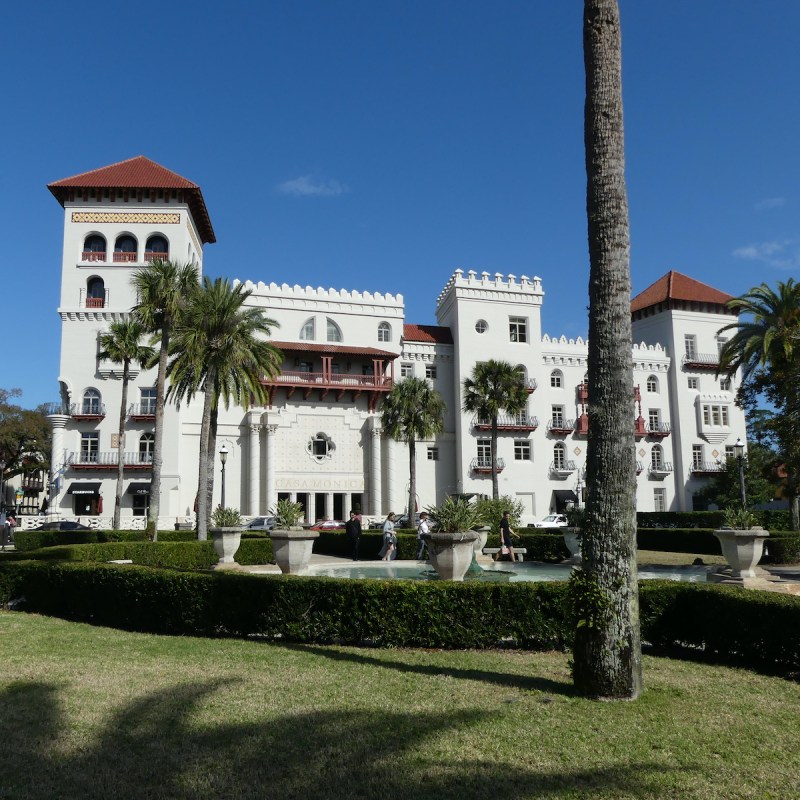
Ranging from Florida to Texas, each of these cities has a long and interesting history. They have unique blends of cultures that make them more accepting of the unknown. It’s not surprising their hotels have spirits that want to remain there.
Videos by TravelAwaits
All the hotels below are members of the Historic Hotels of America program, which requires them to be a national historic landmark or be listed on the National Register of Historic Places. They reflect periods in their respective cities’ histories that inform what they are today. The spirits supposedly within them are not just misty images; they were once real people facing decisions that changed their lives, and sometimes the future.
Note: My stays were comped, but my opinions are my own.

1. Casa Monica
St. Augustine, Florida
As one of America’s most haunted cities, it’s only natural that St. Augustine has a hotel with some distinguished ghosts.
Boston self-taught architect Franklin W. Smith built Casa Monica. Smith, one of oil and rail tycoon Henry Flagler’s former business associates, wanted to get his share of the northern money Flagler’s railroad was bringing to St. Augustine. However, for his grand opening, Smith had the hotel’s furniture shipped on Flagler’s railroad. Somehow, it got misplaced. Smith’s opening flopped. Smith sold the hotel to Flagler for pennies on the dollar. Flagler had no problem getting the hotel furnished on time, and did well with it. In the 1960s, it was converted to the city hall and offices, but in 1999, it again became the Casa Monica Hotel. Today, it operates at the Casa Monica Resort & Spa.
It’s one of the most beautiful hotels in the city — and the most haunted. Guests hear voices when no one is around, phantom footprints appear on the carpet like someone is walking on it, and furniture moves mysteriously. People have seen a woman wearing a green dress walking around the hotel. Others spotted a man in the Henry Flagler Suite when the room was unoccupied. Sometimes guests see a man in period clothing in the lobby who vanishes when they get near him. Maybe Flagler is still enjoying the hotel he whisked away from a competitor.

2. The Don CeSar
St. Pete Beach, Florida
The ghost story at the Don CeSar Hotel grew out of an ill-fated romance. Thomas Rowe was an orphan whose Irish grandfather sent him to England to be educated. One night, he attended a showing of his favorite opera, Maritana. He fell madly in love with the young Spanish singer, Lucinda, who was the female lead. She, in turn, loved the dashing American. They dreamed of spending their lives together in a pink castle by the sea. It sounded like the perfect romance. The fly in the ointment was Lucinda’s parents. Rowe was not what they wanted for their daughter. They whisked her away one night.
Rowe returned to America and became wealthy. He eventually married another woman, but he never forgot his first love. When he constructed a fabulous hotel in St. Petersburg (in an area eventually renamed St. Pete Beach), he designed it with Lucinda in mind. He named it the Don CeSar after a character from the opera. Of course, it was painted pink, and it is still known as “The Pink Palace.” During the Jazz Age, it was a hotspot visited by F. Scott Fitzgerald, Clarence Darrow, Lou Gehrig, Al Capone, and Franklin D. Roosevelt.
After Rowe’s death in 1940, guests and employees reported seeing a white-haired man dressed in a white linen suit and Panama hat. Some smelled a nasty cigarette odor. In life, Rowe had asthma; his doctors prescribed a medicated cigarette. Others have seen a man and woman in period clothing strolling in the lobby. When approached, the couple disappeared.
Rowe seems protective. Once, when a bridal magazine was doing a shoot there, he appeared to one of the journalists and told her, “Do not let her go on the ledge.” The woman dismissed it as a dream until the following day when they were positioning a model near a ledge for a shoot. She cautioned them not to have the model stand too close to the ledge.
The hotel eventually went into decline, and during WWII, it was a veteran’s hospital. Perhaps adding to the spirits of St. Petersburg’s most famous building.
3. Hotel Monteleone
New Orleans, Louisiana
Drawn to the “land of opportunity,” Antonio Monteleone, a young Sicilian shoe manufacturer and nobleman, came to New Orleans. The Hotel Monteleone’s history began in 1886 when Antonio bought the small hotel in the heart of the French Quarter. Since then, five generations of Monteleones have kept Antonio’s dream alive.
As befitting New Orleans with its multitude of ghosts, The Monteleone has more than its share of spirits. It’s been investigated by the International Society for Paranormal Research, which reportedly found at least a dozen active spirits. Many occurrences are on the 14th floor — which is technically the 13th, but the hotel skips 13 on the elevators.
There are two suicide victims whose spirits remain. “Solemn John” is believed to be John Wagner, a wealthy businessman in the 1920s. He was staying at the Monteleone when he died by suicide.
The other suicide was the “Poolside Lady.” Apparently, she and her boyfriend had a suicide pact. She took her life, but he didn’t. She is seen roaming the rooftop pool area.
Antonio Puccio, the creator of the antique clock in the lobby, is sometimes seen working on his clock.
The saddest is Maurice, a toddler, seen on the 14th floor. In the 1800s, Jacques Begere and his wife, Josephine, left their little boy in the care of a nanny while they attended the French Opera House. The hotel says Maurice developed a fever and died while in the nanny’s care. Other accounts claim it was his father who died when his carriage overturned while returning to the hotel, and the mother died of grief — and Maurice now searches the hotel for his parents.

4. Cavalier Hotel
Virginia Beach, Virginia
Prohibition took its toll on many, but the mystery of Adolph Coors’ death in Virginia Beach is one of the strangest examples. Was it an accident, suicide, or murder? Perhaps his ghost, which appears on the sixth floor of the Cavalier, from where he fell from a window, knows. Maybe one of the other ghosts there knows, but no one is telling.
In June 1929, Coors was staying at the Cavalier. He was traveling the country lobbying to get the Prohibition Act repealed. A hotel employee saw what she thought was a pile of clothing lying on the lawn. She went to pick them up and discovered the body. Coors’ room was locked, and there was a note inside telling his estate to pay his hotel bill. The following day, the Virginia Pilot printed an obituary referring to Coors death as a “fall from a window of a Virginia Beach hotel.” The New York Times obituary said he died of a coronary.
Perhaps Coors regretted his decision to end his life, or the obituaries angered him, but almost immediately, people reported seeing him around the hotel. It was so common many people thought the death was a hoax to call attention to his attempts to repeal Prohibition.
Coors isn’t alone at the Cavalier. There’s a bride who died on her honeymoon, a manager, a sailor, a ghostly cat, and others.
Like many grand old hotels, the Cavalier declined and was used during the war years as a Naval radar training school. The reported sailor spirit is believed to be one of the men stationed here then: David Dorn. David met a young WAVE, Helen Weiss, who worked in the training unit. They fell in love and married in 1945. In 1991, they planned to return to celebrate their 47th wedding anniversary. Just a few months before their planned return, David died. Helen donated the flag that had been draped over his coffin to the place where they first found marital bliss. The hotel flew the flag over the hotel. People believe the young sailor seen in the halls is David’s spirit.
Pro Tip: Both the new and original sections of the hotel are fantastic, but if you want to potentially encounter ghostly residents, stay in the original section.

5. Menger Hotel
San Antonio, Texas
As a hotel built on the ground where the Battle of the Alamo was fought, it would be incredible if the Menger wasn’t haunted. The spirits who wander this hotel are some of the most colorful and famous in Texas. To add to the local color, it was the site of Menger Brewery, the first brewery in Texas. By 1857, William Menger, probably tired of his drunken patrons falling asleep in the tavern, built a hotel.
Over the years, many famous guests stayed here. The Menger was considered the finest hotel west of the Mississippi. Robert E. Lee and William Tecumseh Sherman stayed here — not at the same time, or there might be at least one more ghost present. General Kirby Smith stayed here after the fall of the Confederacy. Most of the presidents from Grant to Bush have visited the Menger.
One of them, Theodore Roosevelt, is apparently still hanging around. He recruited his Rough Riders in the little bar off the lobby. A bartender saw Roosevelt one night after closing the bar. When the figure disappeared, the bartender scrambled out without counting the night receipts.
My favorite story is about the two spirits a guest encountered in his room after coming out of the shower. One was dressed in buckskin, and he was arguing about whether to leave the Alamo or remain with an invisible companion.
Pro Tip: Besides being a fantastic place to stay, enjoy great food, and ghost hunt, the sculpture of Colonel Travis drawing his famous line in the sand that adorns the lobby is an artistic, not-to-be-missed treat.
On a marathon of haunted destinations? Check out:

